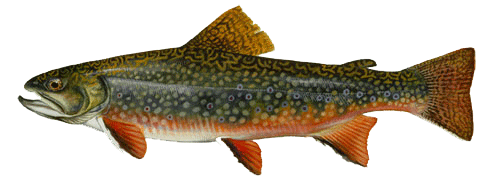| Brook Trout |
 |
Brook Trout |
| Salvelinus fontinalis |
(A.K.A. - Speckled Trout)
|
Key Distinguishing Markings:
- Cream colored spots on a dark background.
Note: All other trout species in Maryland have dark spots on a light background.
- The spots along the back (dorsal) are elongated and appear worm-like.
- The spots below the lateral line are round, red and each is surrounded by a bluish halo.
- The fins along the bottom of brook trout (pectoral, pelvic, and anal fins) are highly distinctive and quite striking.
- They have a white leading edge followed by a black streak with the rest of the fin displaying various shades of red, orange and yellow.
View the Brook Trout Gallery
|
Distribution:
- Native to eastern Canada and northeastern United States; extend as far west as eastern Minnesota.
- Original range also included the Appalachian Mountains where they are still found in many high elevation streams as far south as Georgia.
- They have been widely introduced into several western states.
- Brook trout are the only trout native to Maryland waters.
|
Size:
- Relatively small, rarely growing over 9 to 10 inches.
- A 12 inch is rare and considered a real trophy.
|
Habitat:
- Clean, clear, cold streams.
- In Maryland, there are nearly 100 streams that support native, self-supporting, populations of brook trout.
- Concentrations of brook trout streams are found in central and northern Baltimore County, the Catoctin Mountains of Frederick County and in far western Maryland mainly in Garret County.
|
Spawning:
- Fall months, peaking in late October - early November.
- Using their tail fins, a female constructs a shallow depression in clean stream gravel (called a redd) where she deposits her eggs.
- After the male fertilizes the eggs, the female covers them with gravel.
- The eggs incubate through the winter months and hatch out in the early spring.
|
Fishing Tips:
- Within their native range, brook trout are a prized, though small, game fish with a long heritage of associated fishing lore.
- Because of their small size, at best Maryland streams support relatively low numbers of adult trout.
- Brook trout are easily exploited and for this reason, Maryland DNR keeps these streams in very low profile.
- The lower Savage River below Savage River Dam in Garrett County is our only high-profile, native trout fishery where anglers can expect to catch nice stream-bred brook trout. There are tackle restrictions and harvest limits on this section of the lower Savage so anglers are strongly urged to consult their Sportfishing Guide for details and boundaries.
- For current recreational size and creel limits, see Maryland's updated regulation page.
DNR Fishing Recommendations:
- Do not harvest any native brook trout.
- Return them all to spawn again.
- Use artificial flies and lures to minimize hooking injuries.
|
Fun Fact:
- Brook trout are the only trout native to Maryland waters.
- Maryland DNR does not rear or stock brook trout into any of the State's waters.
- Brook trout normally associated with hatchery production are considered a threat to the genetic integrity of the native brook trout heritage.
For more information about Maryland's brook trout population, visit the Maryland Brook Trout Program webpage.
|
| Family: Salmonidae (Salmonids) |
| Order: Salmoniformes (salmons) |
| Class: Actinopterygii (ray-finned fishes) |
For more information on brook trout and their management, please contact Alan Heft - 301-689-7107.
Illustration: Courtesy of Duane Raver/USFWS
|
